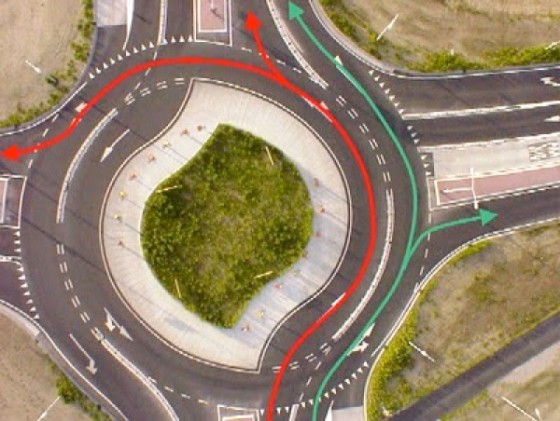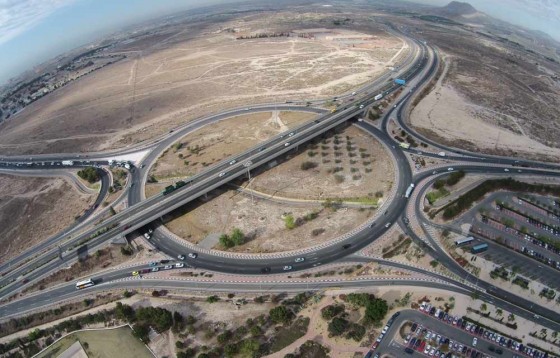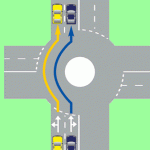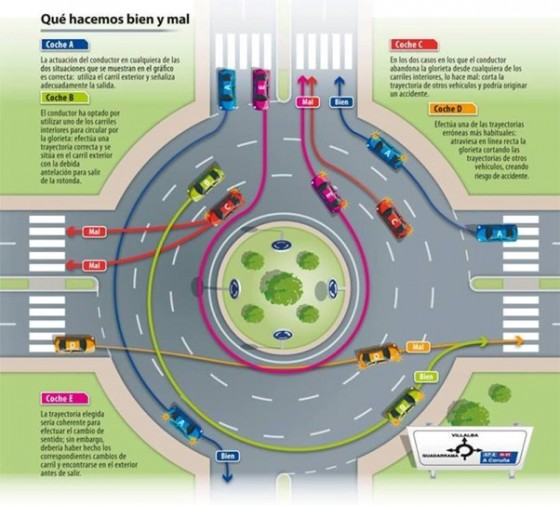If you or anyone you know intend to ride (or drive) in Spain one of the biggest danger hotspots are Spanish roundabouts. Even the Spanish seem confused on how to take them, add the massive herds of tourists and expats, each navigating them as they would at home and you have a recipe for potential disaster. What baffles many used to driving in other countries is that in Spain cars often travel all the way around roundabouts in the outside lane.
In it’s own way the Spanish roundabout system makes sense, whether you agree with it is irrelevant. The whole point of motorcycle touring is to experience motorcycling in a different environment with different views, traditions, weather, languages, food and dare I say it – road rules. If you’re heading for a motorcycle tour of Europe it’s 100% your responsibility to familiarise, understand and respect the road rules of any country you visit. If you can not embrace or enjoy change then it might be best for you to consider only touring in your own county.
How Spanish Roundabouts Work
The following information is not my opinion, all the facts are from either the Guardia Civil Trafico or the DGT Dirección General de Tráfico websites. These facts are valid at the time of writing, July 2016.
For an unprepared foreign motorcyclist on a tour of Spain roundabouts can actually be terrifying, incredibly confusing and extremely dangerous if you attempt to navigate them using the Irish/UK/US system. You’ll get away with it on a quiet roundabout if there’s no cops about, but in a busy coastal town or city like Barcelona you will place yourself and your pillion in a highly dangerous situation unless you drive like the Spanish and understand the Spanish system.
The Spanish Traffic Office have just released this video on the correct way to navigate them specific to Spanish Traffic Law. Remember, the Guardia Civil Trafico always hang out at roundabouts making a fortune in fines with both the Spanish and tourists doing it wrong.
NOTE: Red/Mal = Incorrect Green/Bien = Correct
The Key Principles of Riding in Spain
So here’s the thing, the Spanish treat a roundabout exactly the same way as a straight one-way road with the only difference from Ireland or the UK is that they drive/ride on the right. In Spain there is no difference between a straight 2 lane road and a roundabout, it is the English and the Irish that predominantly treat a roundabout as a separate system, more like a junction incorporating a round immovable obstacle in the center. Imagine we are in Spain, (riding on the right) on a straight 1 lane street with right side junctions only, one of which we want to take. As we ride along the road we know where we want to turn and we carry out the procedure we learnt when a novice rider, speed, mirror, position, signal, manoeuvre, and we turn right from the major road to the minor road.
Now imagine we are in Spain, (riding on the right) on a straight 3 lane road and we want to exit off to the right. The procedure is of course exactly the same, the only difference being that if we are in the central lane for some reason, lane 2, we would normally move back into the right hand lane, lane 1, well before we exercise our procedure to turn right. Now if we apply this system to a Spanish roundabout we are well on the right track.
Check out this video of a Spanish Traffic police officer controlling the traffic on a busy roundabout. The comments are in Spanish, and it’s not exactly exciting viewing, but if you watch you’ll get a sense of what I’m talking about as the cop stops traffic exiting the roundabout from the left/inner lane and the problems drivers cause by doing so.
So what’s the craic with the nutters going right around a roundabout in the rightmost lane? E.g. entering a roundabout in the rightmost lane and remaining there all the way around to exit 3, or even 4. I really struggled with this concept until I got my head around their system.
Let’s imagine we are again on a 3 lane road and we are happily chugging along in lane 1, the rightmost lane. We are in no rush and we have no need to move into lane 2 or 3 to overtake anyone, there are no obstructions either so we ‘aint moving from lane 1. Now the SatNav or map tells us to take the 5th exit to the right 1km ahead. Do we move to the left into lane 2 to pass lane 1 or 2? No. Do we move into lane 3 to pass exit 3 or 4? No, we are happy in lane 1 and we are legally entitled to ride this lane all day if we want, we pass the first four exits then indicate right and exit the 5th. If, as we passed one of the previous exits and some twat in the central lane, lane 2 cut us off to take a right exit directly from the central lane whereby we crashed into him we’d be pissed off, but the law and the insurance company would be on our side as we had right of way!
In Spain, how you exit a roundabout is exactly the same as on a straight road
You’ll see what I mean here at 0:17 of this video.
So, when a car on the inside of the roundabout tries to exit only to have its route blocked by a car travelling all the way round on the outside who is to blame? The answer is the car exiting from the inside lane, be it lane 2 or 3. The car on the outside, the rightmost lane, lane 1 always has the right of way! This will be the case for easily 90-95% of the roundabouts you come upon in Spain.

Take a close look as this is not the typical town roundabout where lane 2 is used for overtaking. This is more typical of a motorway roundabout where there are lane markings on the approach indicating you must be in the correct lane before entering.
In Spain most roundabouts are treated unlike the UK/Ireland where road markings might indicate the left lane is only for traffic taking the first exit (left). The image below is common in UK/Ire but I’ve not come across like this in Spain, see picture above.
Most busy two/three lane roundabouts in the UK and Ireland have clear lane markings indicating which lane to enter for your directions exit. In Spain the vast majority of roundabouts will not have road markings indicating your lane, so if you were to treat a roundabout in Spain as you would the image below it would be illegal. Generally the most likely road marking on a typical Spanish roundabout will simply be the yield sign. If this is the case the best and safest practice is to get into the rightmost lane and stay there. This is not always the case, and traffic might dictate otherwise but on a motorbike any collision is a major collision. I will always choose the safest path in traffic, and on a Spanish roundabout I have found through much trial and error that most of the time taking the rightmost lane slowly is the safest path, most certainly for exits 1 and 2, usually for exit 3 and often for exit 4.The above image is typical of the system in the Ireland/UK/US, but if in Spain you need to forget about this as it will only lead to tears.
Here are the basic rules
Rule 1: Traffic entering the roundabout must yield to traffic that is already inside the roundabout which will run anti-clockwise so you yield to traffic on the left.
Rule 2: This is the REALLY important one: You may ONLY leave the roundabout from the outer “rightmost lane”. Never attempt to exit the roundabout from an “inside lane” – EVER. This is where most people go wrong. You must first merge to the outmost lane well before your exit, respecting any other vehicle’s path, and then exit the roundabout. Traffic that ignores this rule cause most of the accidents, and in Spain at least 12% of all accidents happen on roundabouts. You can not exit directly from the inside lane unless the movement within the roundabout is channelled through suitably marked lanes and road markings. If you are in lane 2 (left) and can not enter lane 1 (rightmost/outside) before your exit then you need to continue around until you can safely enter the rightmost lane before your exit.
Rule 3: Don’t turn on any turning light/indicator when entering the roundabout, again this seems to be specific to Spain. It is mandatory to use the indicator ONLY when switching lanes or exiting the roundabout, except for the 1st exit where it is not obligatory to indicate at all, again Spain specific. I know, that sounds mad and this is where Spain is specifically different from just about every other country, although in my experience most car drivers everywhere seem allergic to using indicators anyway and if they do I’m still wary at best. If you need to take a 3rd, 4th or 5th exit and decide to play safe and stay in the outside rightmost lane I strongly advise to implement what is described as a “courtesy indicator”. This is where you use your left indicator to show you have no immediate intention to exit the roundabout.
There is no requirement to indicate that you are going “straight on” on the roundabout, but as the roundabout often requires quicker responses to movements, indications that we are not turning off by using our left turn indicator, can be considered courteous and affirms your intentions. You would not do this if in the left lane, only if in the rightmost lane. As a motorcyclist I’d consider this absolutely essential as it’s a good defensive riding tactic and it helps highlight your presence, especially at night or in poor visibility conditions. As a motorcyclist you need to be sure any traffic on a roundabouts inside/left lane understands your intentions, especially those who do not know the “exit in the right lane only” rule. Most of the time that will be our fellow tourists, the Spanish might ignore the rule, but at least they are aware of it and that if in the rightmost lane you have the right of way.
To be clear, if the outside/rightmost/normal driving lane is not busy, Spanish law requires you to use it as your primary lane throughout the roundabout no matter what exit you intend to take!
Lets take a closer look at what’s going on in this screenshot from the video at the top of this article.
Car A Blue: The driver of Vehicle A is correct in the two situations shown in the picture. The driver drives in the outer lane and properly indicates the exit he/she is going to take.
Car B Green: The driver has chosen to drive through one of the inner lanes to drive around the roundabout, but he/she moves to the outer line early enough to exit the roundabout.
Car C Red: In the two examples where Vehicle C is exiting the roundabout from the inner lanes, he/she is doing it incorrectly as he/she is cutting other drivers off and could cause an accident. This is a classic move made by UK/Irish and many bad Spanish drivers. You have to watch for these lads cutting in on your front wheel. When in the rightmost lane the safest approach to dealing with this is to firstly slow down to give yourself more reaction time, maneuverability and safer stopping ability, use the left indicator if you intend to continue in this lane and keep one eye on the traffic immediately behind on the left lane. I will typically ride Spanish roundabouts a good bit slower than roundabouts in Ireland, better slow and safe than fast and sorry.
Car D Yellow: The vehicle is making one of the most common wrong maneuvers. The driver is crossing all lanes, thus cutting other drivers up and creating a risk of accident. I see these tossers all the time on quiet roundabouts, you can usually spot them as they are mostly young lads, all balls and no brains and driving too fast anyway. They are annoying but I don’t consider them a big risk to me as I’d spot them easily and just back off to let them ahead. It’s alway better to have aggressive drivers ahead of you than behind you.
Car E Purple: The lane taken by Vehicle E is making a complete balls of it, the driver should have progressively changed lanes earlier and should be in the outer lane before exiting the roundabout.
Notes
Note 2. You must also use the rightmost lane only if you intend to take either the 1st of 2nd exit.
Note 3. If you’re going to exit left, i.e. the 3rd, 4th or 5th exit it’s normal to enter on the left lane and stay on the leftmost lane overtaking traffic aiming for exits 1 and two. Once you’ve spotted the exit you need you indicate right and move into the inner rightmost lane well before you take your final right turn, i.e. the exit. But take close attention to this, it’s only ok to do this if you need to overtake, or if the rightmost/normal driving lane is heavily occupied with other traffic or other hazard.
Note 4. If you’re going to exit left, i.e. the 3rd, 4th or 5th and there is no traffic technically you should do so in the rightmost lane, not the left. And if there is traffic you may still choose the rightmost lane as this lane is the only one that has right of way, and for you as a motorcyclist it may be the safest option as long as you remember to clearly indicate.
As a motorcyclist I only decide to enter on the left lane if I’m taking the 3rd or most likely the 4th exit AND the right lane to the 1st and 2nd exits were heavily congested. However, most of the time I will play it safe, especially with a pillion by entering via the right lane and staying there until I turn off. Remember, in Spain the traffic in the rightmost lane ALWAYS has the right of way. In heavy traffic it can be a bit slower with maybe a bit of a que to enter a roundabout, but it’s often the safest option!
From the Spanish version of the Highway Code
Answer: The answer is simply the same as if the question were “why are there sometimes more than one lane on any road?”, because sometimes more than one lane is needed for the smooth flow of traffic, sometimes you need to use that second lane, but it doesn’t take away from the fact that the right hand lane is Spain’s normal driving lane.
The following explanation is also taken from the Spanish equivalent of the Highway Code.
When there is more than one lane on a roundabout, you will normally travel around the roundabout in the right hand lane – the outside of the roundabout.
So what exactly is the inside lane for?
…to carry out an overtake or if the lane is signed for your direction of travel…
And what should you do if you’re on the inside and want to exit and someone is blocking your way?
…under no circumstances should a driver cut the course of other vehicles using the roundabout in the right hand lane in order to exit from it…
So there you have it. As mad as it might seem to you this is directly from the Spanish version of the Highway Code. Travelling right around the roundabout in the outside (right hand) lane is the correct way of doing it in Spain.
Reality Check: Now the bad part
Many Spaniards are the same as drivers at home and don’t know how to drive in roundabouts, or simply don’t give a rats ass. Sadly many, actually most ignore the “only leave from the outer lane” rule and you’ll find yourself having to drive defensively to avoid a collision. If you want to play it safe, just try to always choose the outer rightmost lane which is what I generally do most of the time. At the very least, even if you do end up in a spill the cops and the insurance companies will view you as the victim rather than the accident cause.
I wish that was the only problem you have to deal with, but it’s not. The English and Irish drivers are a real danger as most will not have heard of or have any understanding of the right hand lane exit rule while the Spanish will at least be aware of it, mostly. And it’s not just the English and the Irish that confuse matters. Spain is also seen as a gateway to North Africa. Many thousansds of North Africans from all over Europe and the UK drive through Spain every summer on their way home via ferries from Barcelona, Valentia, Carthagena and near Gibralta, many of whom have a very liberal view of road rules in general and drive cars in a dangerious state of ill repair. You need to look for these guys, give ‘em a wide birth and never let them drive close behind you, chances are their tyres are bald and their brakes bearly work and treat them like a live hand grenade on a roundabout.
Here are two scenarios that might help you understand how I navigate a typical Spanish 5 exit, 2 lane roundabout. Both are correct, but which one I choose to do will depend which I think is the safest for me based on my view of the traffic conditions at the time. One of the key skills of surviving a Spanish roundabout, apart from understanding the law, is to observe the traffic flow upon approach and have a plan before entering if exiting on the 3rd or 4th exit. Remember, if exiting at exit 1 or 2 always choose the rightmost lane.
Scenario 1 – Low Traffic
- If I want to take the 1st exit I will approach on the right lane, enter roundabout, stay in rightmost lane and indicate right before I exit.
- If I want to take the 2nd exit I will approach on the right lane, enter roundabout, stay in rightmost lane then indicate right before 2nd exit.
- If I want to take the 3rd exit I will approach on the right lane, enter roundabout, stay in rightmost lane indicating left approaching the 2nd exit then indicate right before my exit.
- If I want to take the 4th exit I will approach on the right lane, enter roundabout, stay in rightmost lane indicating left approaching the 2nd and 3rd exits then indicate right before my exit.
- If I want to take the 5th exit I will approach on the right lane, enter roundabout, stay in rightmost lane indicating left approaching the 2nd, 3rd and 4th exits then indicate right before my exit.
Scenario 2 – Heavy & Tourist Traffic
- If I want to take the 1st exit I will approach on the right lane, enter roundabout, stay in rightmost lane and indicate right before I exit.
- If I want to take the 2nd exit I will approach on the right lane, enter roundabout, stay in rightmost lane then indicate right before 2nd exit.
- If I want to take the 3rd exit I will approach on the left lane, enter roundabout, stay in left lane passing exit one, indicate right just before the 2nd exit, enter rightmost/outside lane at or just after exit 2. Then indicate right again and exit at 3rd exit.
- If I want to take the 4th exit I will approach on the left lane, enter roundabout, stay in left lane passing exit 1 and 2, indicate right just before the 3rd exit, enter rightmost lane at or just after exit 3. Then indicate right again and exit at 4th exit.
- If I want to take the 5th exit I will approach on the left lane, enter roundabout, stay in left lane passing exit 1, 2 and 3, indicate right just before the 4th exit, enter rightmost/outside lane at or around exit 4 in plenty of time to indicate right again and exit at 5th exit.
Conclusions
Scenario 1 is the one that causes almost all of the confusion and accidents because it’s counter intuitive to many non Spanish drivers. If you choose this way, while 100% correct you risk being cut off by someone technically doing an illegal maneuver exiting from the left lane. As bikers we all know it’s a poor consolation knowing we were right from a hospital bed. The key trick with Scenario 1 is to ride slow, keep a sharp eye on the traffic directly beside and/or behind in the left lane and indicate left if you intend to continue around in the outer/rightmost lane. Done correctly I often find it the safest option on quiet roundabouts. Remember, on a quiet roundabout you are required by law to only use the rightmost/outside lane anyway. If you are not overtaking you should not be in the left inside lane.
Scenario 2 is the most typical for drivers taking the 3rd, 4th or 5th exits, it suits the Spanish who drive fast and aggressively, and it’s similar to the UK/Irish take on roundabout use with the exception of the rightmost/outside lane exit rule. In summer the Spanish roundabouts are flooded with both expats and tourists who don’t know the rightmost/outside lane exit rule or it’s right of way. Under these conditions I’ll likely use scenario 2 where I have less risk of traffic on my left cutting me off, and if I get into the rightside/outside lane between my exit and the previous exit I avoid cutting off anyone continuing around in the outside lane.
In Scenario 2 – Enter Left, Enter Slow, Go Right Well Before Your Exit and Clearly Indicate!
As every roundabout is highly dependent on the traffic it’s next to impossible to advise on which is the best or safest approach.
Now that you know the law you can choose to either stick to it “with great caution to traffic on the left lane” knowing that you have right of way. Or you can do as the locals do “with great caution to traffic on the right lane” knowing that if you exit from the left lane and the lad in the right lane cuts you off, well it’s you that is in the wrong.
I find that taking close attention to the traffic around me and ahead of me on the approach to a busy roundabout is key. Identify the aggressive drivers or those in a rush and keep a special eye out for non Spanish reg and rental cars as those are the most likely to cause you trouble. Remember, traffic in the rightmost, normal driving/riding lane HAVE RIGHT OF WAY and are not obligated to take any right turn they don’t want to! If a car is in the right hand lane approaching an exit and is not indicating right it can likely continue around blocking your exit unless you are also in the rightmost lane.
Well now, I hope that has left you in no doubt as to how to survive a Spanish roundabout ![]()
Safe riding folks…
Related Article:
Spanish Police Target Motorcyclists in Summer 2016











Very helpful article, Denis. Thanks.
As a driving instructor I would agree that it does have a certain logic. But, as you say, only when other road users also follow the same rules.
I find that roundabouts are the main thing that scares learners when teaching them. I think it’s the feeling that they’re entering into something that they have little control over and have to make decisions quickly.
May be heading towards the Picos in September. Either that or the Dordogne, can’t make up my mind.
Thanks John,
My wife is about to do her test for the driving licence, over the past year it’s been interesting watching her learn how to deal with roundabouts in tourist areas where the rules are “anything goes”. We live in a very touristy town so it’s as much an issue here in Killarney as it was when we lived on the Spanish costas. You can teach or learn the rules as they are stated in the rule book, but the reality is sometimes a bit different. It’s for this reason I won’t be letting my wife relax after she gets her test, I’ll be pushing her to do a few advanced driving skill days to fill in the gaps and hopefully make up for her lack of experience.
I had a bit of a hard time writing this article as any advice I could give is very subjective the the attitudes of the local driving practices. For example, over the years I noticed (with the exception of Barcelona) the driving standards in northern Spain are generally very good, non agressive and road rage is almost non existant. This changes the further south you go and I could take my pick from a long list as for the reasons for that.
Hope you enjoy your trip, both destinations are great but I know which one I’d choose – the Picos via the Dordogne, Pays de Basque, Navarra and Galacia
Thanks for writing in,
Denis
Hi Denis.
Decided to leave the Dordogne this year and go back to the Pyrenees again.
I didn’t get to see as much as I wanted last year (one night!) due to my travelling companion getting a sudden bout of home sickness.
Getting the ferry to Roscoff on the 7th of September, then taking a leisurely couple of days down to Broto where, on your recommendation, I’ve booked into the Hotel Pradas Ordesa for four nights. Then a couple of days back up to Cherbourg for the ferry home.
Going to base myself in Broto and and do a bit of touring around some of the places on your videos with my camera. All on my own, bliss!
Might take a right for the Picos next year.
That’ll be 20k miles on the GS this last 12 months. Going like a dream.
I’ll let you know how I get on.
John.
Hi John,
Sounds like you got a good plan going on there, if you want to explore a region properly you’re most often better off doing it alone. I’ll not have a chance to get back there this year, I got too much going on on the West Coast of Ireland at the moment. But it’s a fairly safe bet I’ll be back in Pyrenees next year then possibly down through the Picos and Portugal to Faro, i.e. a proper west coast route, Donegal to Faro, that’s a route you might want to think about doing sometime, I’ve ridden Donegal to Almeria a few times and it’s an incredible experience.
Give Angel (the Hotel Prada owner) my best, he’s a biker himself and knows the area well, he can supply you with maps and more great roads in the area, he also gives a 10% dscount for booking online (Hotel Prada Ordessa Online Booking)
Be sure to post the video/phonts of your trip somewhere and give me a shout when you get back, maybe we can arrange a few days riding here on the Atlantic coast..
Have a safe trip mate.
Denis